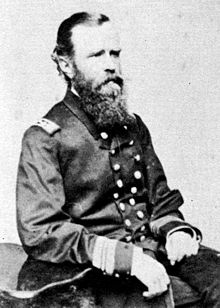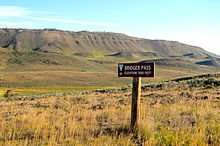mount123
Regular Member
- Messages
- 993
- Reaction score
- 678
- Points
- 93
- Y-DNA haplogroup
- J2b-L283>Y126399
- mtDNA haplogroup
- J1c7a
John Lorimer Worden
J2b-L283>Z1043

John Lorimer Worden (March 12, 1818 – October 19, 1897) was a U.S. Navy officer in the American Civil War, who took part in the Battle of Hampton Roads, the first-ever engagement between ironclad steamships at Hampton Roads, Virginia, on 9 March 1862.
Commanding the Union's only warship of this class, USS Monitor, Worden challenged the Confederate vessel Virginia, a converted steam-frigate that had sunk two Union blockaders and damaged two others. After a four-hour battle, both ships withdrew, unable to pierce the other's armour.
Background and early career
Worden was born in Scarborough, New York. He grew up in Swartwoutville, Dutchess County, New York, and was married to Olivia Toffey, the aunt of Daniel Toffey, captain's clerk of the USS Monitor. He was appointed midshipman in the Navy on January 10, 1834. He served his first three years in the sloop-of-warErie on the Brazil Station. Following that, he was briefly assigned to the sloop Cyane before he reported to the Naval School at Philadelphia, Pennsylvania, for seven months of instruction. He returned to sea in July 1840 for two years with the Pacific Squadron.
Between 1844 and 1846, Worden was stationed at the Naval Observatory in Washington, D.C. During the Mexican–American War, he cruised the west coast, primarily in the store ship Southampton, but in other ships as well. In 1850, he returned to the Naval Observatory for another two-year tour of duty. The ensuing nine years were filled with sea duty which took Worden on several cruises in the Caribbean and Mediterranean Seas.
Taking command of the Monitor
Though still ill as a result of his imprisonment, Lieutenant[1][2] Worden accepted orders to command the new ironclad Monitor on January 16, 1862. He reported to her building site at Greenpoint in Brooklyn on Long Island and supervised her completion. He placed the new warship in commission at the New York Navy Yard on February 25 and two days later sailed for Hampton Roads. However, steering failure forced the ironclad back to New York for repairs. On March 6, she headed south again, this time under tow by Seth Low.
On the afternoon of March 8, Monitor approached Cape Henry, Virginia, while inside Hampton Roads, the Confederacy's own ironclad, CSS Virginia, wrought havoc with the Union Navy's wooden blockading fleet. During that engagement, the Southern warship sank both the sloop USS Cumberland and the frigate USS Congress, as well as severely damaging the steam frigate USS Minnesota before retiring behind Sewell's Point. Arriving on the scene too late to participate in the engagement, Worden and his ship set about assisting the grounded Minnesota.
The battle of the ironclads
At daybreak on the 9th, Virginia emerged once more from behind Sewell's Point to complete her reduction of the Federal fleet at Hampton Roads. As the Confederate ironclad approached Minnesota, Worden maneuvered Monitor from the grounded ship's shadow to engage Virginia in the battle that revolutionized naval warfare. For four hours, the two iron-plated ships slugged it out as they maneuvered in the narrow channel of Hampton Roads, pouring shot and shell at one another to almost no visible effect. Three hours into the slug fest, Worden received facial wounds when a Confederate shell exploded just outside the pilot house that partially blinded him. He relinquished command to his first officer, Samuel D. Greene. About an hour later, Monitor withdrew from the battle temporarily and, upon her return to the scene, found that Virginia, too, had withdrawn. The first battle between steam-driven, armored ships had ended in a draw.
Phylogeographer: John Lorimer Worden was the first famous J2b-L283 known. His descendants helped in part to establish the earliest phylogeny of now prolific J2b-L283>Z1043.
…
The Wordens trace descent to a Peter Worden of Lancashire born before 1574.
http://wordenfamilyassoc.org/John_Lorimer_Worden.htm
https://www.familytreedna.com/public/worden
https://en.wikipedia.org/wiki/John_Lorimer_Worden
J2b-L283>Z1043

John Lorimer Worden (March 12, 1818 – October 19, 1897) was a U.S. Navy officer in the American Civil War, who took part in the Battle of Hampton Roads, the first-ever engagement between ironclad steamships at Hampton Roads, Virginia, on 9 March 1862.
Commanding the Union's only warship of this class, USS Monitor, Worden challenged the Confederate vessel Virginia, a converted steam-frigate that had sunk two Union blockaders and damaged two others. After a four-hour battle, both ships withdrew, unable to pierce the other's armour.
Background and early career
Worden was born in Scarborough, New York. He grew up in Swartwoutville, Dutchess County, New York, and was married to Olivia Toffey, the aunt of Daniel Toffey, captain's clerk of the USS Monitor. He was appointed midshipman in the Navy on January 10, 1834. He served his first three years in the sloop-of-warErie on the Brazil Station. Following that, he was briefly assigned to the sloop Cyane before he reported to the Naval School at Philadelphia, Pennsylvania, for seven months of instruction. He returned to sea in July 1840 for two years with the Pacific Squadron.
Between 1844 and 1846, Worden was stationed at the Naval Observatory in Washington, D.C. During the Mexican–American War, he cruised the west coast, primarily in the store ship Southampton, but in other ships as well. In 1850, he returned to the Naval Observatory for another two-year tour of duty. The ensuing nine years were filled with sea duty which took Worden on several cruises in the Caribbean and Mediterranean Seas.
Taking command of the Monitor
Though still ill as a result of his imprisonment, Lieutenant[1][2] Worden accepted orders to command the new ironclad Monitor on January 16, 1862. He reported to her building site at Greenpoint in Brooklyn on Long Island and supervised her completion. He placed the new warship in commission at the New York Navy Yard on February 25 and two days later sailed for Hampton Roads. However, steering failure forced the ironclad back to New York for repairs. On March 6, she headed south again, this time under tow by Seth Low.
On the afternoon of March 8, Monitor approached Cape Henry, Virginia, while inside Hampton Roads, the Confederacy's own ironclad, CSS Virginia, wrought havoc with the Union Navy's wooden blockading fleet. During that engagement, the Southern warship sank both the sloop USS Cumberland and the frigate USS Congress, as well as severely damaging the steam frigate USS Minnesota before retiring behind Sewell's Point. Arriving on the scene too late to participate in the engagement, Worden and his ship set about assisting the grounded Minnesota.
The battle of the ironclads
At daybreak on the 9th, Virginia emerged once more from behind Sewell's Point to complete her reduction of the Federal fleet at Hampton Roads. As the Confederate ironclad approached Minnesota, Worden maneuvered Monitor from the grounded ship's shadow to engage Virginia in the battle that revolutionized naval warfare. For four hours, the two iron-plated ships slugged it out as they maneuvered in the narrow channel of Hampton Roads, pouring shot and shell at one another to almost no visible effect. Three hours into the slug fest, Worden received facial wounds when a Confederate shell exploded just outside the pilot house that partially blinded him. He relinquished command to his first officer, Samuel D. Greene. About an hour later, Monitor withdrew from the battle temporarily and, upon her return to the scene, found that Virginia, too, had withdrawn. The first battle between steam-driven, armored ships had ended in a draw.
Phylogeographer: John Lorimer Worden was the first famous J2b-L283 known. His descendants helped in part to establish the earliest phylogeny of now prolific J2b-L283>Z1043.
…
The Wordens trace descent to a Peter Worden of Lancashire born before 1574.
http://wordenfamilyassoc.org/John_Lorimer_Worden.htm
https://www.familytreedna.com/public/worden
https://en.wikipedia.org/wiki/John_Lorimer_Worden









